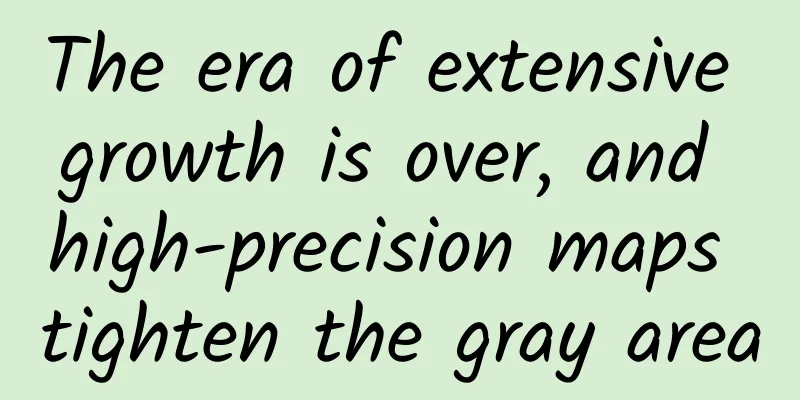The era of extensive growth is over, and high-precision maps tighten the gray area

|
Twenty years ago, people basically relied on active map brains and paper maps for travel; ten years ago, the first generation of electronic navigation maps began to be launched on the vehicle's central control screen, displayed in the form of a 2D plane. The map data basically has road information such as national highways, provincial roads, ring roads, and expressways. Before use, the map data of each city needs to be downloaded to the local computer in advance, and the navigation needs to be upgraded at a 4S store every six months. The second-generation electronic navigation map, which is the navigation map currently used, has the ability to be updated online. The road information is richer and more three-dimensional, and a new function has been added to display road congestion in real time. The navigation can also pop up a guide route when passing through a fork in the road. It can plan the shortest route, the route with the least traffic lights, etc. for users, which is much more convenient than the first-generation map.
As we enter the era of autonomous driving, the emergence of high-precision maps has completely revolutionized the way maps are presented, and has become one of the guarantees for the safety of autonomous vehicles. Maps no longer just provide guidance for humans, but have also become the third eye of machines. As the underlying infrastructure, high-precision maps are very important for the development of autonomous driving. However, after a deeper observation, we may be confused. my country has a vast territory and a large number of cities, but the urban road conditions are extremely complex. It seems that high-precision maps have a large blue ocean and the market is promising, but the number of players participating in the market is very limited. The track demand is strong but the development is very restrained. What is going on? To clarify this issue, we need to briefly understand the two production routes of high-precision maps. Crowdsourcing and professional mappingMap vendors generally use two routes to obtain high-precision map data: crowdsourcing and professional surveying. Crowdsourcing refers to using some equipment on cars driving on the road to obtain road information and upload it. This data includes the driving trajectory and route of vehicles with GPS positioning signals, and camera and radar data uploaded by on-board sensors. Professional surveying refers to using professional surveying vehicles to collect high-precision road information.
Since professional surveying and mapping is too expensive, the cost of a single surveying and mapping vehicle is as high as millions, the number of maps produced is limited, and the update of high-frequency words is slow, many map vendors have set their sights on crowdsourcing collection methods, focusing on both professional surveying and crowdsourcing collection. Map vendors generally use high-precision collection vehicles to complete the initial drawing, and switch to low-precision crowdsourcing collection vehicles to reduce costs during subsequent map updates. We can also clearly see that in recent years, more and more vehicles are equipped with cameras, radars, and driving recorders. The data involved in the production of the two high-precision maps include the precise physical characteristics of the road and the surrounding environment, and also reflect the information of other traffic participants, including the location, speed, driving direction, route, etc. of the participants. The real-time status and historical paths of these cars will be continuously recorded and uploaded. With GPS signals and visual images, the collected information becomes sensitive. Tightening regulatory red linesMap surveying and mapping is a relatively special field. In the process of data collection, editing, and processing of high-precision maps, it often involves the collection and processing of images of geographical coordinates of sensitive targets in my country, and this information is often regarded as a state secret. Therefore, the field of map surveying and mapping is subject to policy supervision and constraints. Not all manufacturers have the money and resources to directly carry out surveying and mapping work. The collection, editing, and processing of map surveying and mapping require surveying and mapping qualifications, which are related to compliance and safety. So, how to obtain the surveying and mapping qualification of maps? There are usually two ways: one is to apply independently, and the other is to acquire a qualified unit. The difficulty and cost of applying for and maintaining the qualification of navigation electronic maps are very high. For example, the standard requirements for the application require that there should be 100 surveying and mapping and related professionals, including at least 10 senior surveyors and 20 intermediate surveyors; at the same time, professional and technical personnel must also meet the academic qualifications, years of work in related positions, and the requirements for obtaining job/professional qualifications.
Due to the high cost of application and maintenance, many large enterprises choose to directly acquire companies with surveying and mapping qualifications, such as Tencent's acquisition of NavInfo and Alibaba's acquisition of AutoNavi. Currently, there are only 24 units that have obtained the qualification, of which 20 are enterprises, including Huawei, JD.com, Didi, Xiaomi, Baidu, Alibaba, Tencent and other enterprises. The small number of participating enterprises and the important reason that restricts map vendors from entering this track are the limitations of its laws and regulations, the difficulty in obtaining and maintaining qualifications, and the high cost of long-term investment. This is a game that only large enterprises with money can afford to play, and small enterprises cannot afford to play with them. The development of the Internet has entered a deep-water stage. In view of the increasingly strict cybersecurity review for information security, information security is increasingly valued, and high-precision maps, which are rich in map content and sensitive information of people, will only be more rigorous in terms of review. Didi was hit hard when it went public in the United States, and this incident was characterized as endangering national data security and national security. Now Didi APP is still off the shelves, and Didi has also been required to enter and implement cybersecurity inspections. Didi is not a map service provider, but it has a large amount of map information and passenger information in its business. It is also held hostage by the policy. Whether some sensitive data is also packaged and exported together, it is not surprising that it will be hit hard if the disclosure is incomplete. For the industry, Didi's review is a wake-up call. Map vendors must use information legally and in compliance with regulations, especially when it comes to information going abroad, which must be reviewed and evaluated for security. Once there are illegal acts such as leakage, tampering, and selling, disaster will come. The increasingly stringent policy red lines have brought the relatively extensive development of high-precision maps to an end. Map vendors need to develop in an orderly manner within the policy rules. The entire process of map collection, production, storage, and release must be carried out under the supervision of the Ministry of Natural Resources. Staff involved in the mapping also need to undergo confidentiality training and sign a confidentiality agreement. According to industry insiders, the current review department is very strict in reviewing high-precision maps, and the entire process takes almost a month. In the early days, the state's supervision of the field of map surveying and mapping was not very strict. Now the loose days of map vendors are coming to an end. The development of the industry has become more standardized and orderly, and has entered a stage of refined development. The development of high-precision maps needs to comply with national requirements on map data security and personal information protection. Although there are constraints on the development of the industry, in the long run it also regulates the healthy development of the industry. In the early development of the industry, policies and regulations did not have corresponding supporting measures and rules for new things. After the industry has undergone rapid iterative development, some information security hazards have been exposed in the process of disorderly development. The red line of policies and regulations must be tightened to constrain. Policies and regulations have always developed in parallel with the industry, achieving technological upgrades and breakthroughs within a controllable range. Issues that need to be discussed beyond regulationsPlato said that laws and regulations are a golden, flexible rope. In the development of high-precision maps, when this golden rope is tightened, we cannot act recklessly and only seek development. The premise of the development of the industry is to hold the golden rope of regulations in one hand and the banner of evolution in the other. The development of high-precision maps has moved from technology research and development to the stage of large-scale investment. The demand for data collection and scene segmentation is huge. In the future, there are two issues other than regulations that restrict the development of high-precision maps that need to be discussed and resolved. One is the problem of unifying map data models and exchange formats. Currently, all high-precision map players are playing their own games, with different equipment and methods for collecting and processing data. As a result, the final data standards are inconsistent, which hinders the choices of car companies and the healthy development of the industry. Therefore, it is necessary to promote the formation of unified standards for map content, data format, publishing and transmission, and update management, which is of great significance for the subsequent interaction and sharing of data. At present, map vendors are actively participating in the discussion and formulation of the standard for the exchange format of dynamic map information data. The relevant discussion standard plan has been drafted and is being improved. It is obvious that the data model and exchange format standards of electronic maps will be unified in the future, which will help reduce the development time and cost of automobile manufacturers.
The second is the solution to the issue of deflection plug-in errors. In terms of data quality, due to the principle of data confidentiality, the map system uses encryption algorithms to encrypt the geographic location, which will lead to information distortion. The deflection plug-in error on the vehicle side is about 1.7 meters. This data error is risky for high-precision maps. Directly relying on the absolute positioning of high-precision maps while driving may lead to lane matching errors. Map vendors need to consider technical solutions to deal with the matching accuracy of vehicle-side positioning, continue to study the encryption information decryption matching technology, and discuss with the national surveying and mapping department on the confidentiality of high-precision maps and the limitation range of deflection plug-ins. Whether it is the data security level or the development of technology decryption, we have found that high-precision maps have entered the stage of large-scale commercialization, and the gray area of extensive management in the industry has gradually disappeared. Map information is increasingly strictly controlled. Data information is the fuel for technological development, but the legal acquisition and use of fuel are very important. For high-precision maps, in terms of data security and network security, exploration under the premise of ensuring information compliance is the guarantee of long-term development. Only by traveling thousands of miles can you see the vastness of the world, but without navigation maps, it is really difficult to travel thousands of miles. Similarly, for smart cars, high-precision maps are the foundation for smart cars to open up the world and one of the guarantees for safe driving of smart cars. Especially under the general trend of vehicle-road collaborative development, high-precision maps are indispensable for the construction and verification of smart roads, the development of V2X, etc., and are the core underlying capabilities for promoting the development of autonomous driving. If high-precision maps develop smoothly under constraints, our autonomous driving will run more steadily and farther on the road. |
<<: Android source code advanced Glide loading process and source code detailed explanation
Recommend
Watching 300 Douyin videos a day made me rethink Toutiao
Douyin has become a hot commodity. Compared with ...
Drinking moderately can soften blood vessels? Rumor! These 5 points are really helpful...
As we age People will feel that their bodies are ...
Lenovo reflects on its pre-installed promise, Windows 10 products will remove unnecessary software
A malicious software called Superfish (called spy...
Unable to escape "Internetization", BTA has already targeted the film industry
January 13 (Reporter Zhang Zhichang) Even without...
Perfect Diary’s private domain traffic method!
The article provides a detailed analysis of the t...
WeChat applet development practice - using UUID, Base64, Chance, etc.
[[173391]] UUID The node-uuid module can quickly ...
Dali said Qianchuan advanced course: Douyin Qianchuan advanced delivery, from entry to mastery of a one-stop solution
Dali said Qianchuan advanced course: Douyin Qianc...
Momo promotion: Momo product analysis report!
Momo is a pan-entertainment and pan-social platfo...
Stop swallowing pills! These pills can also be chewed
Author: Huang Yanhong Duan Yuechu In daily life, ...
In 2019, 60% of advertisers' budgets were given to self-media!
Today, Weibo released its latest annual self-medi...
Master these seven principles to improve user login success rate!
TCC Recommendation: Hello everyone, this is TCC T...
OS X is not secure? But it is better than Windows.
[[152379]] Apple's OS X desktop operating sys...
200,000-level domestically produced large seven-seater, the new Tang DM-i and the Trumpchi ES9, which one do you choose?
On October 25, the 2025 BYD Tang DM-i was officia...
What advertising resources are available on Sogou Search PC desktop?
In this article, the editor will introduce to adv...
On the third day of the first lunar month, burn door god paper to pray for peace and prosperity. Do these five things to ensure auspiciousness.
The third day of the first lunar month is also kn...









